
Red Rocks - Southwest trip, 2012
"TSEYI'" or CANYON DE CHELLY,
National Monument
Arizona
| Canyon de Chelly (and no-one seems to know where that name came from, the Navajo call it Tseyi') is a spectacular canyon located on the "Big Rez", the giant Navajo or Dine reservation. The reservation comprises 27,425 square miles, roughly the size of West Virginia. However, only about 22,000 people actually live on the Rez. When we arrived at our motel in the little town of Chinle, we were extremely surprised to discover that we basically got the last room (the one facing the main street). This was surprising since it was still early in the year (early April) and I had booked the room perhaps two months earlier. The puzzle was solved, when we were told that Johnny Depp was filming "the Lone Ranger" in the canyon and pretty much the entire motel had been booked for the crew. Not the stars. And no, we never did see Johnny or any other stars. Although once we got into the canyon, we did drive past the fenced off staging area for the film. Therefore, unfortunately, as the saying goes: "Close but no cigar'. | ||||
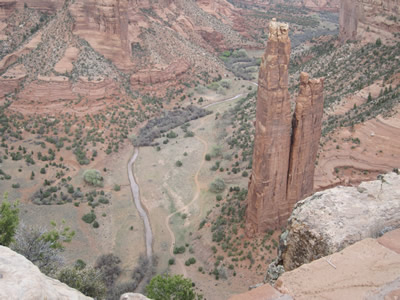 |
The pictures shows the canyon looking down from the rim drive. On the left is "Spider Rock" a rather impressive rock formation that looks like a highrise building. Down bellow one can see a dirt track aka road. All wheel drive or mules are highly recommended for traversing the canyon. The canyon was designated a National Monument in 1931, largely to protct the ruins and other archeological remains that testify to more than 4,000 years of human presence in the canyon. (The president can simply declare |
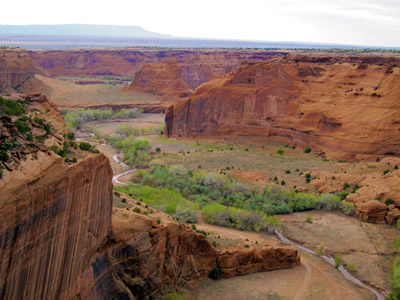 |
||
| an area a National Monument, National Park designation requires congressional approval. You do the math! Since the canyon is located on "sovereign" Indian land, it is administered jointly by the US park service and the Navajo Nation. As a result, about 40 Navajo families whose ancestors had lived in the canyon before it was designated as a national monument still have the right to live in the canyon and use the land to make a living. It appears that some use their property as summer grazing or growing land, while others cater to the tourists who find their way into the canyon. To visit Canyon de Chelly requires that one either go on an authorized group tour or hire a Navajo guide. Since our car was entirely unsuitable for driving on the canyon's dirt roads or, sometimes, through the river, we not only hired a guide, but his suburban as well. Below I am admiring the rocks with our guide - Bobby Van Winkle; in the middle picture is our transportation standing below one of the impressive rocks at the edge of a wash. Since the "four corners" area had very little snowfall, there was comensurately little water in the wash (or creek, take your pick). Still, my Audi would not have looked pretty after trying to drive through the canyon. | ||||
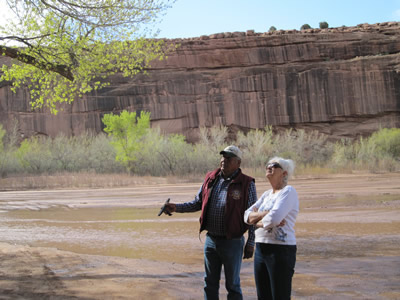 |
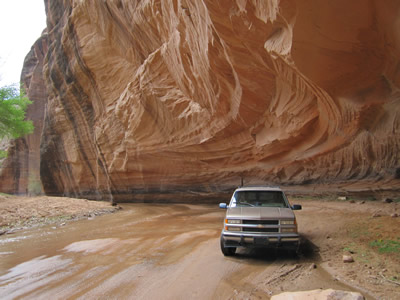 |
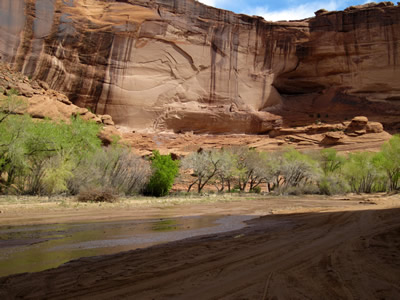 |
||
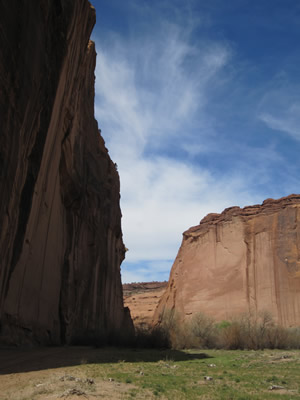 |
The canyon has spectacular scenery (my beloved "Red Rocks") that has been carved by water over the millenia. As can be seen from the few pictures, every scene shows a different, awe inspiring rock formation. The landscape is stark and beautiful, the rock is the attraction, since there is very little vegetation to hide its structure. Since we visited in early Spring, there was some greenery along the wash to really set off the red rocks. Although Canyon de Chelly is in a desert and looks quite forbidding, it has been inhabited by humans for more than 4,000 years. Below are pictures of "Anazasi" ruins |
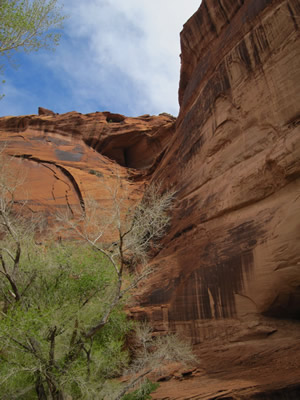 |
||
| or more politically correct of the "ancient pueblo people" who today are claimed as the ancestors of the Hopi and Zuni tribes. "Anazasi" apparently is a Navajo term meaning "ancient enemies". Since we are outsiders and do not have a dog in this particular fight, we call them according to the preferences of whoever we are with. While we do not know exactly who the builders of the houses below were, it is known that they inhabited the canyon for several hundred (thousand?) years until Canyon de Chelley, just like Chaco Canyon and Mesa Verde were eventually abandoned in the 14th century. It is believed that the reason was an unrelenting drought that eventually forced the people to move to the more hospitable environment along the Rio Grande. The ruins today are fenced off to protect what is left from looters. Apparently, only officially sanctioned archeologists are normally permitted access. Or, of course Hollywood. One of the fences we saw was obviously brand new - I bet that if we should actually watch the new "Lone Ranger" movie we will recognize Johnny Depp cavorting among the ruins! We, however, had to stay outside the fenced area. To actually tour ruins we had to wait until Chaco Canyon. | ||||
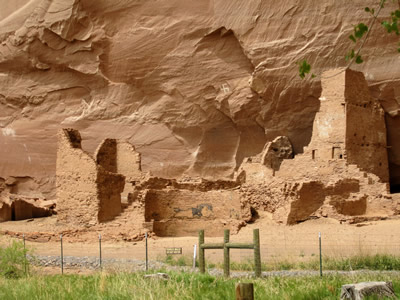 |
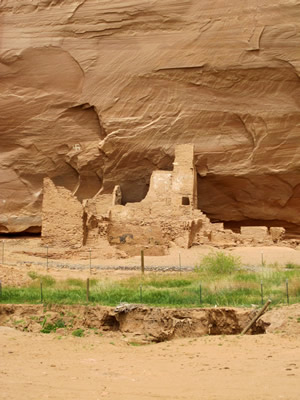 |
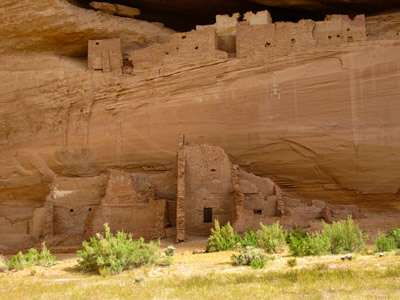 |
||
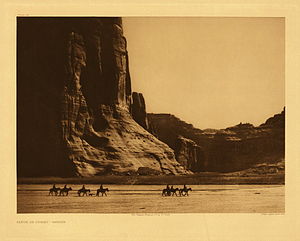 |
Although the cliff dwellings were abandoned in the 14th century, human habitation continued off and on through the centuries, probably depending on water resources. On the right and left are old pictures showing Navajo occupants of the canyon. Below is a picture of a pictograph on one of the rocks showing conquistadors on horses - evidence of human occupation in the 17th century. | 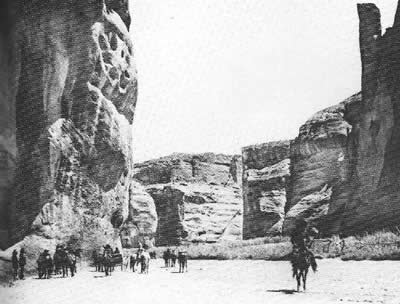 |
||
| By that time the Navajo had migrated into the Southwest from Canada and today occupy this area in somewhat uneasy co-operation with the Hopi and Zuni tribes. Life on the Rez is pretty harsh. Most of the area is too remote to make Casinos viable. And, let's face it Casinos have largely become the lifeblood of Indian economy in the US. The land is to fragile to support large scale grazing - it was pretty much ruined through overgrazing in the 19th and 20th century. Mineral rights were either confiscated by the US government and granted to White settlers | 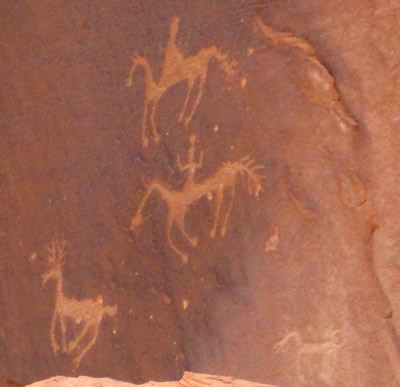 |
or sold for small sums by ignorant and impoverished Indians. And, finally there is the still unresolved scandal of the Bureau of Indian Affairs mismanagent or simply outright theft of royalty payments that had contractually been agreed to. A particulary terrible scandal involves the large scale Uranium mining that took place on the Rez in the 50s and 60s. Mining concens abandoned the area, once the mines had either played out or the demand for Uranium had declined, the radioactive tailings were left behind, leading to horrendous health problems for the local population. No effort to clean up this | ||
| mess has been made to date, unllike in Moab, Utah where a major Superfund operation is under way to remove Uranium tailings over the next 15 to 20 years. But then, Moab is a rich Mormon tourist town, not an impoverished , nominally "sovereign" Indian nation. | ||||
EditRegion4